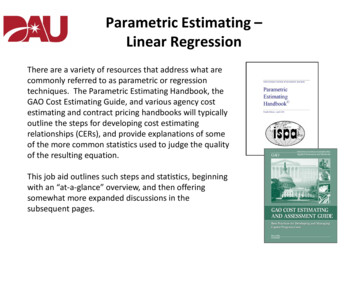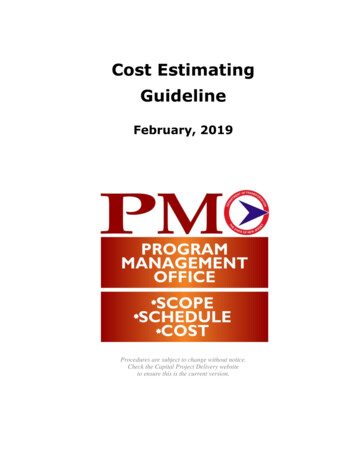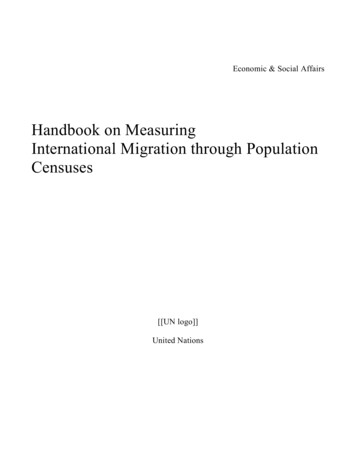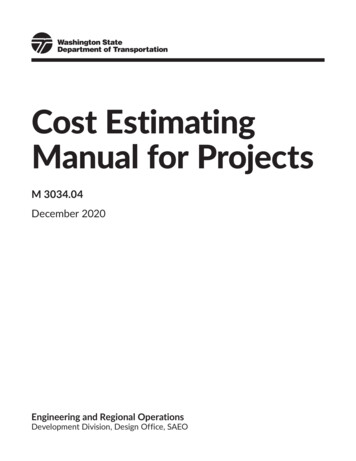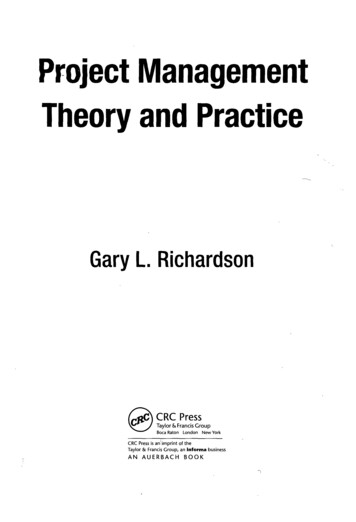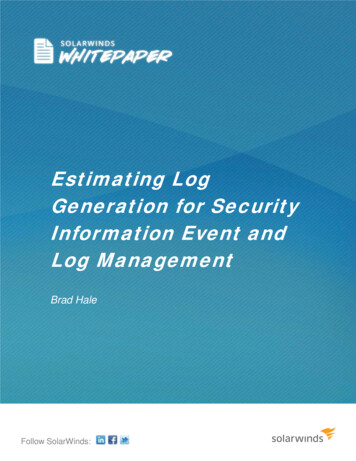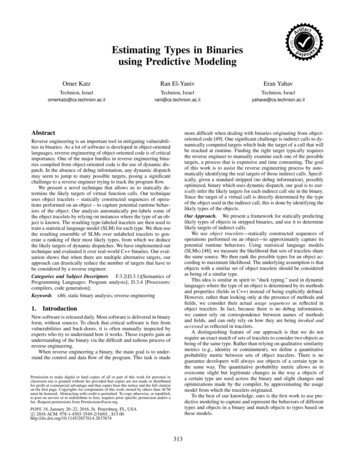
Transcription
tifacteuOPL ** P se * Consi* Easy toedRntat e dTechnion, IsraelTechnion, IsraelTechnion, ilmore difficult when dealing with binaries originating from objectoriented code [49]. One significant challenge is indirect calls to dynamically computed targets which hide the target of a call that willbe reached at runtime. Finding the right target typically requiresthe reverse engineer to manually examine each one of the possibletargets, a process that is expensive and time consuming. The goalof this work is to assist the reverse engineering process by automatically identifying the real targets of those indirect calls. Specifically, given a standard stripped (no debug information), possiblyoptimized, binary which uses dynamic dispatch, our goal is to statically infer the likely targets for each indirect call site in the binary.Since the target of a virtual call is directly determined by the typeof the object used in the indirect call, this is done by identifying thelikely types of the objects.Our Approach. We present a framework for statically predictinglikely types of objects in stripped binaries, and use it to determinelikely targets of indirect calls.We use object tracelets—statically constructed sequences ofoperations performed on an object—to approximately capture itspotential runtime behaviors. Using statistical language models(SLMs) [48], we measure the likelihood that sets of tracelets sharethe same source. We then rank the possible types for an object according to maximum likelihood. The underlying assumption is thatobjects with a similar set of object tracelets should be consideredas being of a similar type.This idea is similar in spirit to “duck typing,” used in dynamiclanguages where the type of an object is determined by its methodsand properties (fields in C ) instead of being explicitly defined.However, rather than looking only at the presence of methods andfields, we consider their actual usage sequences as reflected inobject tracelets. In fact, because there is no debug information,we cannot rely on correspondence between names of methodsand fields, and can only rely on how they are being invoked andaccessed as reflected in tracelets.A distinguishing feature of our approach is that we do notrequire an exact match of sets of tracelets to consider two objects asbeing of the same type. Rather than relying on qualitative similaritymetrics (e.g., identity or containment), we define a quantitativeprobability metric between sets of object tracelets. There is noguarantee developers will always use objects of a certain type inthe same way. The quantitative probability metric allows us toovercome slight but legitimate changes in the way a objects ofa certain type are used across the binary and slight changes andoptimizations made by the compiler, by approximating the usagemodel from which the tracelets originated.To the best of our knowledge, ours is the first work to use predictive modeling to capture and represent the behaviors of differenttypes and objects in a binary and match objects to types based onthese models.Reverse engineering is an important tool in mitigating vulnerabilities in binaries. As a lot of software is developed in object-orientedlanguages, reverse engineering of object-oriented code is of criticalimportance. One of the major hurdles in reverse engineering binaries compiled from object-oriented code is the use of dynamic dispatch. In the absence of debug information, any dynamic dispatchmay seem to jump to many possible targets, posing a significantchallenge to a reverse engineer trying to track the program flow.We present a novel technique that allows us to statically determine the likely targets of virtual function calls. Our techniqueuses object tracelets – statically constructed sequences of operations performed on an object – to capture potential runtime behaviors of the object. Our analysis automatically pre-labels some ofthe object tracelets by relying on instances where the type of an object is known. The resulting type-labeled tracelets are then used totrain a statistical language model (SLM) for each type. We then usethe resulting ensemble of SLMs over unlabeled tracelets to generate a ranking of their most likely types, from which we deducethe likely targets of dynamic dispatches. We have implemented ourtechnique and evaluated it over real-world C binaries. Our evaluation shows that when there are multiple alternative targets, ourapproach can drastically reduce the number of targets that have tobe considered by a reverse engineer.Categories and Subject Descriptors F.3.2(D.3.1)[Semantics ofProgramming Languages: Program analysis]; D.3.4 [Processors:compilers, code generation];Keywords x86; static binary analysis; reverse engineering1.Eran Yahavomerkatz@cs.technion.ac.ilAbstractaluRan El-YanivEvOmer Katzll DocumWeeEstimating Types in Binariesusing Predictive ModelingA EC *st* Complete*ten*ArIntroductionNew software is released daily. Most software is delivered in binaryform, without sources. To check that critical software is free fromvulnerabilities and back-doors, it is often manually inspected byexperts who try to understand how it works. Those experts gain anunderstanding of the binary via the difficult and tedious process ofreverse engineering.When reverse engineering a binary, the main goal is to understand the control and data flow of the program. This task is madePermission to make digital or hard copies of all or part of this work for personal orclassroom use is granted without fee provided that copies are not made or distributedfor profit or commercial advantage and that copies bear this notice and the full citationon the first page. Copyrights for components of this work owned by others than ACMmust be honored. Abstracting with credit is permitted. To copy otherwise, or republish,to post on servers or to redistribute to lists, requires prior specific permission and/or afee. Request permissions from Permissions@acm.org.POPL’16, January 20–22, 2016, St. Petersburg, FL, USAc 2016 ACM. 978-1-4503-3549-2/16/01. 15.00http://dx.doi.org/10.1145/2837614.2837674313
language structure. As a result, there are fewer structural hints torely on, and the behavior takes a more prominent role.Such object and type descriptions can be used to answer difficult questions in a statistical manner, using classification basedon our trained models. In this paper we discuss an application ofour approach to determining probable targets for virtual calls, andprobable types for objects, in stripped binaries.We note that the choice of which actions are recorded as partof a behavior, which kind of statistical model to use, and howto solve the classification problem are all design choices. For example, the statistical model could be a fixed-rank n-gram model,some sort of a blended model employing Katz’s backoff [14, 28],or other variable-order Markov model (VMM) implementations. Inour evaluation, we show that picking a variable-order model is superior to using a fixed-order (as expected), but even within the different choices of variable-order model algorithms, our experienceindicates that certain implementations perform better than others.Virtual Function Tables (vtables). The virtual table of a C class contains function pointers to all of the class’s virtual methodimplementations. Virtual tables support dynamic dispatch by allowing a runtime choice of which function implementation to invoke.Whenever an object invokes a call to a virtual method, the actualcall target is selected by referring to the virtual table of the appropriate class. The notion of an explicit type in this paper refers to thelow-level concept of a vtable created for each class by the compiler, and a the size of memory allocated for the class’ instances.Problem Definition. Given a program in the form of a standardstripped binary b, we denote by VC(b) the set of all virtual calls inb, and by V F(b) all the possible targets of virtual calls. Our goal isto estimate for each virtual call vc VC(b) the likelihood that itstarget is some function vf V F(b).Towards that end, we have to solve the intermediate problem ofestimating the likely types of objects. We use points-to analysis toobtain a set of abstract objects denoted by Ob jects(b) (specificallypointers to objects) in the binary b, and extract the set Types(b)of explicit types (virtual function tables) in the binary. We wouldlike to estimate, for each o Ob jects(b) and t Types(b), thelikelihood of o being of type t, that is, Pt (o) where Pt (o) is theprobability that o matches the model M(t) which represents type t.Motivating Example.Consider the simple example sendIntshown in Fig. 1. This C function takes two parameters: a socketand an integer. If the int parameter is non-zero, the function sendsits value using the socket. Otherwise, it sends a default value. Thefunction returns an error code produced by the socket operations.This function yields the unoptimized x86 assembly code of Fig. 2.We assume the function was compiled using Microsoft’s VisualStudio compiler [2] and uses the application binary interface (ABI)set by the compiler for 32-bit x86 binaries (see Section 5 fordetails). For this example, we use unoptimized assembly code asit is easier to understand. However, we note that our technique alsoworks on optimized code and was evaluated on optimized binaries.The code receives two arguments, [esp 4] (corresponds to theSocket argument) and [esp 8] (corresponds to the int argument).For simplicity, we omitted from the assembly code some instructions, such as prolog, epilog, and other compiler added instructionsthat do not deal with the objects of the function.The virtual calls to connect, send, and sendDefault result inthe calls in lines 7, 16 and 23 respectively. These calls implementthe C dynamic dispatch of virtual functions, where the targetof the call is only determined at runtime. Our goal is to staticallydetermine the possible targets for these calls by inferring the likelyexplicit types for the objects (corresponding to objects from thesource code) on which they are invoked, [esp 4] in this case.The combination of object tracelets and predictive modelingprovides a powerful tool to capture usage, behaviors and characteristics of objects and types in a binary. This combination can alsobe extended to measure similarity between whole programs, ratherthan between objects. The SLMs can also be used to compute likelyshared models for type behaviors, from which a behavior-basedtype hierarchy can be deduced.Existing Techniques. Static analysis of binaries is known to be ahard problem (e.g., [7, 45, 47]). A lot of past work has focused onidentifying variables and aggregate type information [5] in binarieswith no debug information. Very little work has attempted to matchtargets to call sites or types to objects. We address this challenge,which we believe to be very valuable in practice. We do not attemptto recover all aggregate structures in the program, or to identifyall variables. Nor do we try to force a single target for each callsite or a single type for each object. Rather, we produce rankedlists of likely types per object, based on statistical language models(SLMs), and from these deduce ranked lists of likely targets per callsite (see Section 4 for details). A similar problem was previouslydiscussed in [4] but with poor results.We draw some inspiration from classic work on reconstructionof aggregate types in COBOL [41]. This work showed that uniqueusage and access patterns can be used to accurately split aggregatetypes into smaller atomic types. We rely on unique probabilities ofsets of patterns and match them against types found in the binary.We produce our rankings statically without executing the binary.Dynamic approaches cannot reach the same level of coverage of thebinary as static approaches. Additionally, dynamic approaches cannot track all the events we wish to track and at the same granularitywithout prohibitively slowing down the program.Main Contributions. This paper makes the following contributions: We introduce a new approach to dealing with the difficult taskof reverse engineering binaries, using predictive modeling andstatistical approaches. This approach can be also applied toother difficult reverse engineering tasks. We show that object tracelets can accurately determine the typeof an object, and thus the targets of indirect calls, even in realworld binaries where extensive optimization and stripping havebeen applied and no debug information is present. We show that SLMs are a viable model for representing objectbehavior. We use them as a tool to measure correlation betweenobjects and types and estimating types of objects. We implement our approach and evaluate it over real-worldstripped binaries. We were able to reduce the number of likelytargets to fewer than 3 for over 80% of virtual call sites over allbenchmarks. We provide a simple static solution, with high success rates,diminishing the need to manually reverse engineer binaries.2.OverviewIn this section, we provide an informal overview of our approach.We use a simple example for illustrative purposes. More realisticexamples can be found in Section 6.Type as a statistical model of behaviors.In this paper wedescribe a type/object not by its name or its fields and functions butby the way it is used. The description of an object is the behaviorit exhibits, as represented by sequences of actions applied to theobject, and similarly for types. We refer to these descriptions asimplicit types, and use them to train models that represent the types.In stripped binaries, there are no variable names, and no source314
1314151617181920212223242526class BasicSocket { // socket interfacevirtual void connect () 0;virtual void receive () 0;virtual void close () 0;int errorCode , address ;};class MySocket : public BasicSocket {virtual void send (int n );virtual void sendDefault ();int msgCounter ;};class MinimalSocket : public BasicSocket {virtual void send ();};class OneWaySocket : public BasicSocket {int msgCounter ;};class MyFile {virtual void close ();virtual void open ();virtual void seek (int n );virtual void remove ();virtual char* read ();virtual void write (char* str );char * name , current , * path ;int size ;MyFile * parent ;};int sendInt ( MySocket * s , int x)s - msgCounter 0;s - connect ();if (x) {s - send (x );} else {s - sendDefault ();}return s - errorCode ;}mov eax, [esp 4]mov [eax 16] , 0mov eax, [esp 4]mov edx, [eax]mov ecx, [esp 4]mov eax, [edx]call eaxcmp [esp 8] , 0jz branchmov eax, [esp 8]push eaxmov eax, [esp 4]mov edx, [eax]mov ecx, [esp 4]mov eax, [edx 12]call eaxjmp mergebranch :mov eax, [esp 4]mov edx, [eax]mov ecx, [esp 4]mov eax, [edx 16]call eaxmerge :mov eax, [esp 4]mov eax, [eax 4]; virtual call; virtual call; virtual callFigure 2: Assembly code generated for function sendInt. Lines7,16,23 match the function invocations at lines 33,35,37 of Fig. 1.{4. For each o Ob jects(b) we rank all t Types(b) accordingto Pt (o) s OT (o) Pt (s) such that Pt (s) is the probability of soriginating from the model M(t). The highest ranked type t ispronounced the most likely type for o.Extract Object Tracelets. We begin by identifying the abstractobjects in the function. We rely on a simple points-to analysis todetermine aliasing between registers and memory locations that(may) correspond to object references. For the code of Fig. 2 thereis a single object of interest, [esp 4], referred to henceforth as o1(identification of objects is described in Section 5.2):int readLast (char* data ) {MyFile * f new MyFile ();f - open ();f - seek (f - size );return f - current ;} The register eax in lines 3, 12 and 19 points to o1 . The register edx in lines 4, 13 and 20 points to [o1 ], which isthe virtual table of o1 , located at offset 0 in the object’s memory.Figure 1: Class definitions and example codes using MySocket andMyFile. Function sendInt send a value determined by input througha socket and function readLasT returns last character of a file. The register eax in lines 6, 15 and 22 eventually points to anentry in the virtual table of o1 , and that entry is the call target.Illustrating Our Technique. The main idea of our technique isto statically compute a set of object tracelets for each object inthe program, and use the computed set of tracelets as an implicitobject type. Note that in stripped binaries all types share a commonnamespace for fields and virtual functions – the offsets. Under thisnamespace all types structurally resemble each other and the onlydifference between the types is the order and sequences of actions(rather than the kinds of actions), as embodied in our tracelets.Our technique consists of four steps:1. Given a program in the form of a stripped binary b, we identify explicit types Types(b) in b. For each t Types(b),instances(t) is a set of objects of type t (see Section 4.2 fordetails). From instances(t) we extract T T (t) tr1 ,tr2 , ., aset of tracelets for t, known as “type tracelets,” such thattri σi,1 , σi,2 , . and σi, j Σ, as defined in Section 3.2.2. We build a set of statistical language models {M(t) t Types(b)}by training M(t) on the corresponding T T (t).3. For each o Ob jects(b) we extract OT (o), a set of tracelets forobject o, known as “object tracelets.”315Statically Tracking Events for Objects of Interest. We focus onobject o1 . Because eax in line 1 points to o1 , we can determine thatthe “mov [eax 16],0” instruction in line 2 assigns the value 0 to afield of o1 . Similarly, we statically determine that, since eax in line25 also points to o1 , the “mov eax,[eax 4]” instruction in line 26reads a value from a field of o1 . Overall, we statically observe thefollowing explicit events: (i) a write to field at line 2, (ii) a readfrom field in line 26, (iii) virtual calls at lines 7,16 and 23.We also observe 6 implicit events in this example: (i) an accessto the object’s virtual table (read of the field in offset 0) in lines 4,13 and 20, and (ii) the object is used as the this pointer (pointed toby ecx) in lines 5, 14 and 21. Overall, 11 events are performed onthe tracked object.We employ a points-to analysis that allows us to determine theaccesses to objects in the binary (we discuss the analysis furtherin Section 5). Our analysis statically tracks the events as theyappear in the function and extracts sequences of events (the objecttracelets) as a representation of the object’s behavior. The trackedevent sequences are illustrated in Fig. 3a. The nodes in the figurerepresent the events and the superscript numbers correlate to therelevant line of assembly code. The events are marked as follows:
(a) object o1(b) MyFile12345678910111213141516171819202122(c) MySocketFigure 3: Example tracelets for object o1 extracted from functionsendInt, type MyFile from function readLast, and type MySocket.pushcallmovcallmovmov16newecx, eaxMyFile :: MyFileecx, eax[f], eax,eax,[f][eax][f][edx]; virtual call[f][eax 16][f][edx][f][eax 8]; virtual call[f][eax 8]Figure 4: Assembly code generated for function readLast. Lines12,20 match function invocations at lines 44,45 of Fig. 1.1. W(x) – write to field of object at offset x2. R(x) – read from field of object at offset x3. C(x) – call to virtual function of object at offset x4. this – object was used as this pointerAdditional kinds of events are explained in Section 3.The two extracted sequences will be used as our object tracelets.Computing Reference Types. To match the object tracelets wecollected with an explicit type, we need reference data on which totrain our SLMs. We build the reference data by collecting objecttracelets correlating to objects for which the explicit type can bedetermined. We call these tracelets “type tracelets.” An explicit typecan be determined when, for example, we observe the allocation orinitialization of the object.The function readLast in Fig. 1 is part of the same binary assendInt. This function yields the x86 assembly code of Fig. 4. Forsimplicity, we omitted some instructions (prolog, epilog, etc.) fromthe assembly code. Similarly to the extraction of object traceletsfor the object o1 of sendInt, from this function we can extractthe tracelet in Fig. 3b for the object represented by the value of[f]. Because [f] holds the return value of the constructor of typeMyFile, we know that [f] is of type MyFile and we associate thetracelet in Fig. 3b with type MyFile (See Section 4.2 for details).In a similar manner we found additional locations where wecould determine the types of objects and associate their corresponding tracelets with the relevant types. Fig. 3c shows an exampletracelet collected for the type MySocket.Correlating Implicit and Explicit Types. We match differentobjects (implicit types) and (explicit) types based on the probabilitythat their sets of tracelets originated from the same model. Wecreate a model based on the set of tracelets corresponding to theexplicit type and match the tracelets of the object to that model, asdescribed in Section 4.3.Since we are looking to find o1 ’s actual allocated type, we canimmediately eliminate BasicSocket as a candidate because it isan interface. Interfaces have purely virtual functions (without anyconcrete implementation), which have a unique representation inthe binary and cannot be allocated.Because some actions are not feasible for certain types, suchas reading a field at an offset that doesn’t exist, some types areunlikely to be the type of an object. Such types cannot be candidatesfor o1 ’s type. Consider the set of tracelets we extracted for theobject o1 . These tracelets access a field at offset 12, the third field ofthe object, and call a function at offset 16, the fifth virtual functionof the object. The type MinimalSocket does not have a third fieldand the type OneWaySocket does not have a fifth virtual function.We use this knowledge to determine that the types MinimalSocketand OneWaySocket cannot be candidates for o1 ’s type.From now on, we focus only on the likely candidates of o1 ’stype, MySocket and MyFile.The SLM models we use to match objects and types are VMMs.When sequences and dependencies in the data are not known tohave a fixed length, as is the case in our scenario, VMMs are anatural model to use. Our VMMs are based on an n-gram modelwith smoothing and backoff mechanisms. We note that n-grammodels are, in essence, Markov models of fixed-order n 1, wherethe probability of an event is determined based solely on the n 1events that preceded it. The backoff mechanism transforms thefixed-order n-gram model to a variable-order Markov model byallowing to revert to a lower-order model when the current modeldoesn’t hold enough data. Specifically, we use the prediction bypartial match (PPM) algorithm [15].We compute the probability that each of o1 ’s tracelets fromFig. 3a originated from the resulting models (according to the formulas in Section 4.1) and multiply the results to get a score for theentire set (as explained in Section 4.3). Using the trained models,the probability that o1 ’s tracelets originated from MySocket’s modelis found to be drastically higher than the probability that they originated from MyFile’s model. We thus see that MySocket’s model ismore likely to be the origin model, meaning that MySocket is morelikely to be o1 ’s type. This result matches the actual type declaredin the code in Fig. 1.Knowing the likely type of o1 is MySocket, we can now deducethat the likely targets of the virtual calls in lines 7,16 and 23of Fig. 2 are the relevant implementations of MySocket’s functions.3.Object TraceletsIn this section, we discuss the notion of object tracelets. First webriefly describe the dynamic dispatch mechanism used for virtualfunction calls. We then define the set of actions we track anddescribe the method used to extract object tracelets.This section assumes the technical aspects of analyzing the binary, locating objects and types, and determining events are known.In this section we only discuss the general notion of object traceletsas used in the context of our technique. The technical details can befound in Section 5.316
Table 1: Descriptions of the events tracked by our analysisEventC(i)R(i)W (i)thisArg(i)retcall( f )3.1In real (optimized) code such branches are highly unlikely as theywould usually be optimized out of the binary.Because our object tracelets are intra-procedural, when encountering calls and returns we do not follow them. Instead we recordthe relation between the call/return and the object as events (for example, virtual call on an object, object passed as argument, etc.)along with the call itself (for non-virtual calls, as a call( f ) event).The call( f ) event contains the address of the concrete functioncalled. In that way we use all the knowledge available to us fromthe binary. We evaluated whether including the address of the concrete function has an affect on our results. Experiments on a sampleof our benchmarks showed the effects to be mostly marginal.The sets of type tracelets are constructed as the union of alltracelets of objects predetermined to belong to the same type (asdescribed in Section 4.2).DescriptionCall to a virtual function at offset i in the object’s virtual tableRead from a field at offset i in the objectWrite to a field at offset i in the objectObject passed as this pointer to a function.Object-oriented code uses a special pointer known as the thispointer for functions of class instances. This pointer is used tostore the address of the class instance currently in use.Object passed as i-th argument to a functionObject returned from called functionA call to a concrete function f .Marks the possible existence of actions on the object outsidethe scope of the current function. Relevant mostly when theobject is used as an argument or as this pointer.Object Tracelets of MySocket instance. We examinethe function sendInt from Fig. 1. This function dealswith the object s of type MySocket. From our symbolic execution for object s we get two object tracelets:(i)W (msgCounter),C(connect),C(send), R(errorCode),and(ii) W (msgCounter),C(connect),C(sendDefault), R(errorCode).For simplicity, we left the events of the above example as highlevel actions (with field and function names). When translated tothe appropriate stripped assembly level object tracelets, we get thetracelets from Fig. 3a.Virtual Functions and Dynamic DispatchVirtual functions are a mechanism of object-oriented code that allows the program to choose the desired implementation at runtime.When calling a virtual function, the implementation that will beexecuted is determined according to the actual runtime type of theobject used and not necessarily according to its declared type. Thismechanism is implemented using dynamic dispatch.A type’s virtual functions are translated to a virtual functiontable, which contains pointers to the code of all the virtual functionsof the type. Instances of that type hold a pointer to the virtualfunctions table, which is assigned by the type’s constructor atinstance initialization. For example, in our setting, the constructorwill assign the address of the virtual table to the object’s first field.When calling a virtual function, the program first accesses theobject’s stored pointer to get the relevant virtual function table. Anoffset into the table is selected, according to the required virtualfunction, from which the virtual function address is retrieved, towhich the program then jumps. When examining a virtual functioncall in a binary, what can be observed is a pair of reads frommemory and a jump to an address stored in a register. There are noindications of the actual virtual table and/or virtual function used.3.24.In Section 3, we showed how to extract object tracelets for eachobject in the binary. In this section, we show how to assign objectsto their likely types. First, we give a brief background of SLMsand VMMs in Section 4.1. In Section 4.2, we show how to map aset of object tracelets to a specific type in cases where the type isexplicitly used in the program. Then, in Section 4.3, we use VMMsto build a ranking of possible types for each object.4.1Statistical Language ModelsIn this work we use statistical language models to rank the possibletypes for an object.Let Σ be a finite alphabet, and suppose we are given a trainingsequence qN1 q1 q2 · · · qN , qi Σ, assumed to have emerged fromsome unknown stochastic source. Our goal is to learn a probabilistic model P that will be able to assign probability P(σ s) to any future symbol σ Σ given any past s Σ . The model P can then beused to evaluate the likelihood of any test sequence x1T x1 · · · xTusing the law of total probability, P(x1T ) ΠTi 1 P(xi x1 · · · xi 1 ).We can thus utilize P for analysis, prediction and inference. Thisability is the main criterion a model has to meet to fit our needs.Moreover, given a number M of different training sequences assumed to have emerged from M different sources, we can build Mseparate models, one for each source, and use them for classification and ranking of new test sequences.A bottleneck when considering a fixed order model is that overestimating or underestimating the most effective order k can beharmful. On the one hand, the size of the training sample requiredto obtain an accurate model grows exponentially with the order k,so overestimation is problematic in the absence of a sufficientlylarge training sequence. On the other hand, small order modelingoften fail to capture important behaviors that can only be characterized by sufficiently large contexts. In many real-world sett
dictive modeling to capture and represent the behaviors of different To the best of our knowledge, ours is the first work to use pre- these models. c types and objects in a binary and match objects to types based on POPL'16 Estimating Types in Binaries using Predictive Modeling Omer Katz Technion, Israel omerkatz@cs.technion.ac.il Ran El-Yaniv

